Antimicrobial Properties of a Peptide Derived from the Male Fertility Factor kl2 Protein of Drosophila melanogaster
Abstract
:1. Introduction
2. Materials and Methods
2.1. Fly Strains
2.2. Bacterial Strains
2.3. Peptides
2.4. Sequence Analysis
2.5. Antimicrobial Assays
2.6. Drosophila Infection
2.7. qRT-PCR
- male fertility factor kl2kl-2 FORWARD: GGAGTACCAGGAATGGTTCGkl-2 REVERSE: TTGAATTAGGGCTCGAAAAAGC
- Control for the experiment:DrosocinDro FORWARD: ATTTGTCCACCACTCCAAGCDro REVERSE: GATGACTTCTCCGCGGTATGCecropinCCecC FORWARD: CATCAGTCGCTCAGTTTCCACecC REVERSE: TTCCCAGTCCTTGAATGGTT
- Housekeeping gene:Ribosomal protein L32RpL32 FORWARD: ATGCTAAGCTGTCGCACAAATGRpL32 REVERSE: GTTCGATCCGTAACCGATGT
2.8. Bacteria Load in Infected Flies
2.9. Transmission Electron Microscopy (TEM)
2.10. Statistical Analysis
3. Results
3.1. Identification of Homologs of Chemerin-p4 Peptide
3.2. Peptide MFF-p1 Demonstrates Antimicrobial Activity against E. coli and B. subtilis In Vitro
3.3. MFF-p1 Disrupts Integrity of Bacterial Superficial Layers
3.4. The Expression of Male Fertility Factor kl-2 Is Clock Controlled
3.5. Male Fertility Factor kl2 Is Upregulated by Bacteria and Controls Bacteria Load in D. melanogaster
4. Discussion
Supplementary Materials
Author Contributions
Funding
Institutional Review Board Statement
Informed Consent Statement
Data Availability Statement
Acknowledgments
Conflicts of Interest
References
- Wang, G.; Li, X.; Wang, Z. APD3: The antimicrobial peptide database as a tool for research and education. Nucleic Acids Res. 2016, 44, D1087–D1093. [Google Scholar] [CrossRef] [Green Version]
- Steiner, H.; Hultmark, D.; Engström, Å.; Bennich, H.; Boman, H.G. Sequence and specificity of two antibacterial proteins involved in insect immunity. Nature 1981, 292, 246–248. [Google Scholar] [CrossRef]
- Czaplewski, L.; Bax, R.; Clokie, M.; Dawson, M.; Fairhead, H.; Fischetti, V.A.; Foster, S.; Gilmore, B.F.; Hancock, R.E.W.; Harper, D.; et al. Alternatives to antibiotics-a pipeline portfolio review. Lancet Infect. Dis. 2016, 16, 239–251. [Google Scholar] [CrossRef] [Green Version]
- Forbes, S.; McBain, A.J.; Felton-Smith, S.; Jowitt, T.A.; Birchenough, H.L.; Dobson, C.B. Comparative surface antimicrobial properties of synthetic biocides and novel human apolipoprotein E derived antimicrobial peptides. Biomaterials 2013, 34, 5453–5464. [Google Scholar] [CrossRef] [PubMed]
- Kragol, G.; Lovas, S.; Varadi, G.; Condie, B.A.; Hoffmann, R.; Otvos, L. The antibacterial peptide pyrrhocoricin inhibits the ATPase actions of DnaK and prevents chaperone-assisted protein folding. Biochemistry 2001, 40, 3016–3026. [Google Scholar] [CrossRef]
- Åsling, B.; Dushay, M.S.; Hultmark, D. Identification of early genes in the Drosophila immune response by PCR-based differential display: The Attacin A gene and the evolution of attacin-like proteins. Insect Biochem. Mol. Biol. 1995, 25, 511–518. [Google Scholar] [CrossRef]
- Cudic, M.; Bulet, P.; Hoffmann, R.; Craik, D.J.; Otvos, L. Chemical synthesis, antibacterial activity and conformation of diptericin, an 82-mer peptide originally isolated from insects. Eur. J. Biochem. 1999, 266, 549–558. [Google Scholar] [CrossRef] [PubMed]
- Hedengren, M.; Borge, K.; Hultmark, D. Expression and evolution of the Drosophila Attacin/Diptericin gene family. Biochem. Biophys. Res. Commun. 2000, 279, 574–581. [Google Scholar] [CrossRef] [PubMed]
- Bulet, P.; Urge, L.; Ohresser, S.; Hetru, C.; Otvos, L. Enlarged scale chemical synthesis and range of activity of drosocin, an O-glycosylated antibacterial peptide of Drosophila. Eur. J. Biochem. 1996, 238, 64–69. [Google Scholar] [CrossRef]
- Fehlbaum, P.; Bulet, P.; Michaut, L.; Lagueux, M.; Broekaert, W.F.; Hetru, C.; Hoffmann, J.A. Insect immunity: Septic injury of drosophila induces the synthesis of a potent antifungal peptide with sequence homology to plant antifungal peptides. J. Biol. Chem. 1994, 269, 33159–33163. [Google Scholar] [CrossRef]
- Levashina, E.A.; Ohresser, S.; Bulet, P.; Reichhart, J.-M.; Hetru, C.; Hoffmann, J.A. Metchnikowin, a Novel Immune-Inducible Proline-Rich Peptide from Drosophila with Antibacterial and Antifungal Properties. Eur. J. Biochem. 1995, 233, 694–700. [Google Scholar] [CrossRef] [PubMed]
- Hultmark, D.; Steiner, H.; Rasmuson, T.; Boman, H.G. Insect Immunity. Purification and Properties of Three Inducible Bactericidal Proteins from Hemolymph of Immunized Pupae of Hyalophora cecropia. Eur. J. Biochem. 1980, 16, 7–16. [Google Scholar] [CrossRef] [PubMed]
- Ekengren, S.; Hultmark, D. Drosophila cecropin as an antifungal agent. Insect Biochem. Mol. Biol. 1999, 29, 965–972. [Google Scholar] [CrossRef]
- Cociancich, S.; Ghazi, A.; Hetru, C.; Hoffmann, J.A.; Letellier, L. Insect defensin, an inducible antibacterial peptide, forms voltage-dependent channels in Micrococcus luteus. J. Biol. Chem. 1993, 268, 19239–19245. [Google Scholar] [CrossRef]
- Tzou, P.; Reichhart, J.M.; Lemaitre, B. Constitutive expression of a single antimicrobial peptide can restore wild-type resistance to infection in immunodeficient Drosophila mutants. Proc. Natl. Acad. Sci. USA 2002, 99, 2152–2157. [Google Scholar] [CrossRef] [PubMed] [Green Version]
- Banas, M.; Zabieglo, K.; Kasetty, G.; Kapinska-Mrowiecka, M.; Borowczyk, J.; Drukala, J.; Murzyn, K.; Zabel, B.A.; Butcher, E.C.; Schroeder, J.M.; et al. Chemerin Is an Antimicrobial Agent in Human Epidermis. PLoS ONE 2013, 8, 2–9. [Google Scholar] [CrossRef]
- Albanesi, C.; Scarponi, C.; Pallotta, S.; Daniele, R.; Bosisio, D.; Madonna, S.; Fortugno, P.; Gonzalvo-Feo, S.; Franssen, J.D.; Parmentier, M.; et al. Chemerin expression marks early psoriatic skin lesions and correlates with plasmacytoid dendritic cell recruitment. J. Exp. Med. 2009, 206, 249–258. [Google Scholar] [CrossRef] [Green Version]
- Luangsay, S.; Wittamer, V.; Bondue, B.; De Henau, O.; Rouger, L.; Brait, M.; Franssen, J.-D.; de Nadai, P.; Huaux, F.; Parmentier, M. Mouse ChemR23 Is Expressed in Dendritic Cell Subsets and Macrophages, and Mediates an Anti-Inflammatory Activity of Chemerin in a Lung Disease Model. J. Immunol. 2009, 183, 6489–6499. [Google Scholar] [CrossRef] [PubMed]
- Nagpal, S.; Patel, S.; Jacobe, H.; DiSepio, D.; Ghosn, C.; Malhotra, M.; Teng, M.; Duvic, M.; Chandraratna, R.A.S. Tazarotene-induced gene 2 (TIG2), a novel retinoid-responsive gene in skin. J. Invest. Dermatol. 1997, 109, 91–95. [Google Scholar] [CrossRef] [PubMed] [Green Version]
- Banas, M.; Zegar, A.; Kwitniewski, M.; Zabieglo, K.; Marczynska, J.; Kapinska-Mrowiecka, M.; LaJevic, M.; Zabel, B.A.; Cichy, J. The expression and regulation of chemerin in the epidermis. PLoS ONE 2015, 10, e0117830. [Google Scholar] [CrossRef] [PubMed]
- Kulig, P.; Kantyka, T.; Zabel, B.A.; Banaś, M.; Chyra, A.; Stefańska, A.; Tu, H.; Allen, S.J.; Handel, T.M.; Kozik, A.; et al. Regulation of Chemerin Chemoattractant and Antibacterial Activity by Human Cysteine Cathepsins. J. Immunol. 2011, 187, 1403–1410. [Google Scholar] [CrossRef] [PubMed] [Green Version]
- Takahashi, M.; Okimura, Y.; Iguchi, G.; Nishizawa, H.; Yamamoto, M.; Suda, K.; Kitazawa, R.; Fujimoto, W.; Takahashi, K.; Zolotaryov, F.N.; et al. Chemerin regulates β-cell function in mice. Sci. Rep. 2011, 1, 123. [Google Scholar] [CrossRef]
- Godlewska, U.; Brzoza, P.; Sroka, A.; Majewski, P.; Jentsch, H.; Eckert, M.; Eick, S.; Potempa, J.; Zabel, B.A.; Cichy, J. Antimicrobial and attractant roles for chemerin in the oral cavity during inflammatory gum disease. Front. Immunol. 2017, 8, 353. [Google Scholar] [CrossRef] [Green Version]
- Godlewska, U.; Bilska, B.; Zegar, A.; Brzoza, P.; Borek, A.; Murzyn, K.; Bochenska, O.; Morytko, A.; Kuleta, P.; Kozik, A.; et al. The antimicrobial activity of chemerin-derived peptide p4 requires oxidative conditions. J. Biol. Chem. 2019, 294, P1267–P1278. [Google Scholar] [CrossRef] [Green Version]
- Damulewicz, M.; Świątek, M.; Łoboda, A.; Dulak, J.; Bilska, B.; Przewłocki, R.; Pyza, E. Daily regulation of phototransduction, circadian clock, DNA repair, and immune gene expression by heme oxygenase in the retina of drosophila. Genes 2019, 10, 6. [Google Scholar] [CrossRef] [PubMed] [Green Version]
- Zhang, Z.; Schäffer, A.A.; Miller, W.; Madden, T.L.; Lipman, D.J.; Koonin, E.V.; Altschul, S.F. Protein sequence similarity searches using patterns as seeds. Nucleic Acids Res. 1998, 26, 3986–3990. [Google Scholar] [CrossRef] [Green Version]
- Eisenberg, D.; Wilcox, W.; McLachlan, A.D. Hydrophobicity and amphiphilicity in protein structure. J. Cell. Biochem. 1986, 31, 11–17. [Google Scholar] [CrossRef] [PubMed]
- Drozdetskiy, A.; Cole, C.; Procter, J.; Barton, G.J. JPred4: A protein secondary structure prediction server. Nucleic Acids Res. 2015, 43, W389–W394. [Google Scholar] [CrossRef] [PubMed]
- Godlewska, U.; Bilska, B.; Majewski, P.; Pyza, E.; Zabel, B.A.; Cichy, J. Bacteria Modify Their Sensitivity to Chemerin-Derived Peptides by Hindering Peptide Association With the Cell Surface and Peptide Oxidation. Front. Microbiol. 2020, 11, 1819. [Google Scholar] [CrossRef]
- Stone, E.F.; Fulton, B.O.; Ayres, J.S.; Pham, L.N.; Ziauddin, J.; Shirasu-Hiza, M.M. The circadian clock protein timeless regulates phagocytosis of bacteria in Drosophila. PLoS Pathog. 2012, 8, e1002445. [Google Scholar] [CrossRef]
- Younes, S.; Al-Sulaiti, A.; Nasser, E.A.A.; Najjar, H.; Kamareddine, L. Drosophila as a Model Organism in Host–Pathogen Interaction Studies. Front. Cell. Infect. Microbiol. 2020, 10, 214. [Google Scholar] [CrossRef] [PubMed]
- Pandey, U.B.; Nichols, C.D. Human disease models in drosophila melanogaster and the role of the fly in therapeutic drug discovery. Pharmacol. Rev. 2011, 63, 411–436. [Google Scholar] [CrossRef] [Green Version]
- Ganesan, S.; Kamma, A.; Nicholas, P.; Neal, S. NF-κB/Rel Proteins and the Humoral Immune Responses of Drosophila melanogaster. Curr. Top Microbiol Immunol 2011, 349, 25–60. [Google Scholar] [CrossRef] [PubMed]
- Bartolo, G.; Gonzalez, L.O.; Levitin, A.; Shilman, M.M. Drosophila melanogaster y chromosome genes affect male sensitivity to microbial infections. Insects 2021, 12, 30. [Google Scholar] [CrossRef]
- Yokayama, K.; Miyashita, T.; Araki, Y.; Ito, E. Structure and functions of linkage unit intermediates in the biosynthesis of ribitol teichoic acids in Staphylococcus aureus H and Bacillus subtilis W23. Eur. J. Biochem. 1986, 161, 479–489. [Google Scholar] [CrossRef]
- Brown, S.; Meredith, T.; Swoboda, J.; Walker, S. Staphylococcus aureus and Bacillus subtilis W23 make polyribitol wall teichoic acids using different enzymatic pathways. Chem. Biol. 2010, 17, 1101–1110. [Google Scholar] [CrossRef] [PubMed] [Green Version]
- Hanson, M.A.; Lemaitre, B. New insights on Drosophila antimicrobial peptide function in host defense and beyond. Curr. Opin. Immunol. 2020, 62, 22–30. [Google Scholar] [CrossRef]
- Nishide, Y.; Kageyama, D.; Yokoi, K.; Jouraku, A.; Tanaka, H.; Futahashi, R.; Fukatsu, T. Functional crosstalk across IMD and Toll pathways: Insight into the evolution of incomplete immune cascades. Proc. R. Soc. B Biol. Sci. 2019, 286, 20182207. [Google Scholar] [CrossRef] [PubMed] [Green Version]
- Kutch, I.C.; Fedorka, K.M. Y-linked variation for autosomal immune gene regulation has the potential to shape sexually dimorphic immunity. Proc. R. Soc. B Biol. Sci. 2015, 282, 20151301. [Google Scholar] [CrossRef]
- Zhang, J.; Luo, J.; Chen, J.; Dai, J.; Montell, C. The role of y chromosome genes in male fertility in drosophila melanogaster. Genetics 2020, 215, 623–633. [Google Scholar] [CrossRef] [PubMed]
- Carvalho, A.B.; Lazzaro, B.P.; Clark, A.G. Y chromosomal fertility factors kl-2 and kl-3 of Drosophila melanogaster encode dynein heavy chain polypeptides. Proc. Natl. Acad. Sci. USA 2000, 97, 13239–13244. [Google Scholar] [CrossRef] [PubMed] [Green Version]
- Tzou, P.; Ohresser, S.; Ferrandon, D.; Capovilla, M.; Reichhart, J.M.; Lemaitre, B.; Hoffmann, J.A.; Imler, J.L. Tissue-specific inducible expression of antimicrobial peptide genes in Drosophila surface epithelia. Immunity 2000, 13, 737–748. [Google Scholar] [CrossRef] [Green Version]
- Tingvall, T.Ö.; Roos, E.; Engström, Y. The imd gene is required for local Cecropin expression in Drosophila barrier epithelia. EMBO Rep. 2001, 2, 239–243. [Google Scholar] [CrossRef] [PubMed] [Green Version]
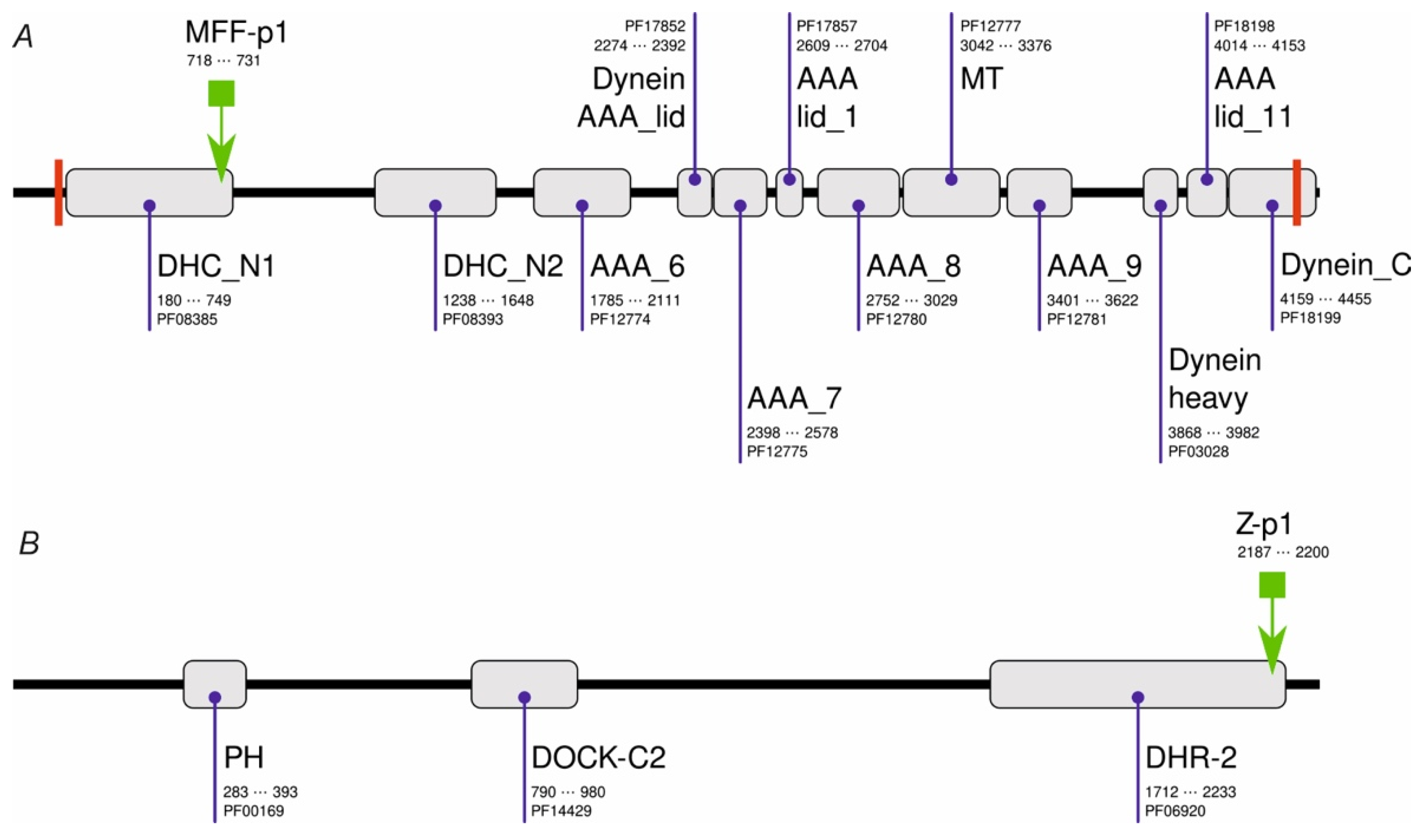
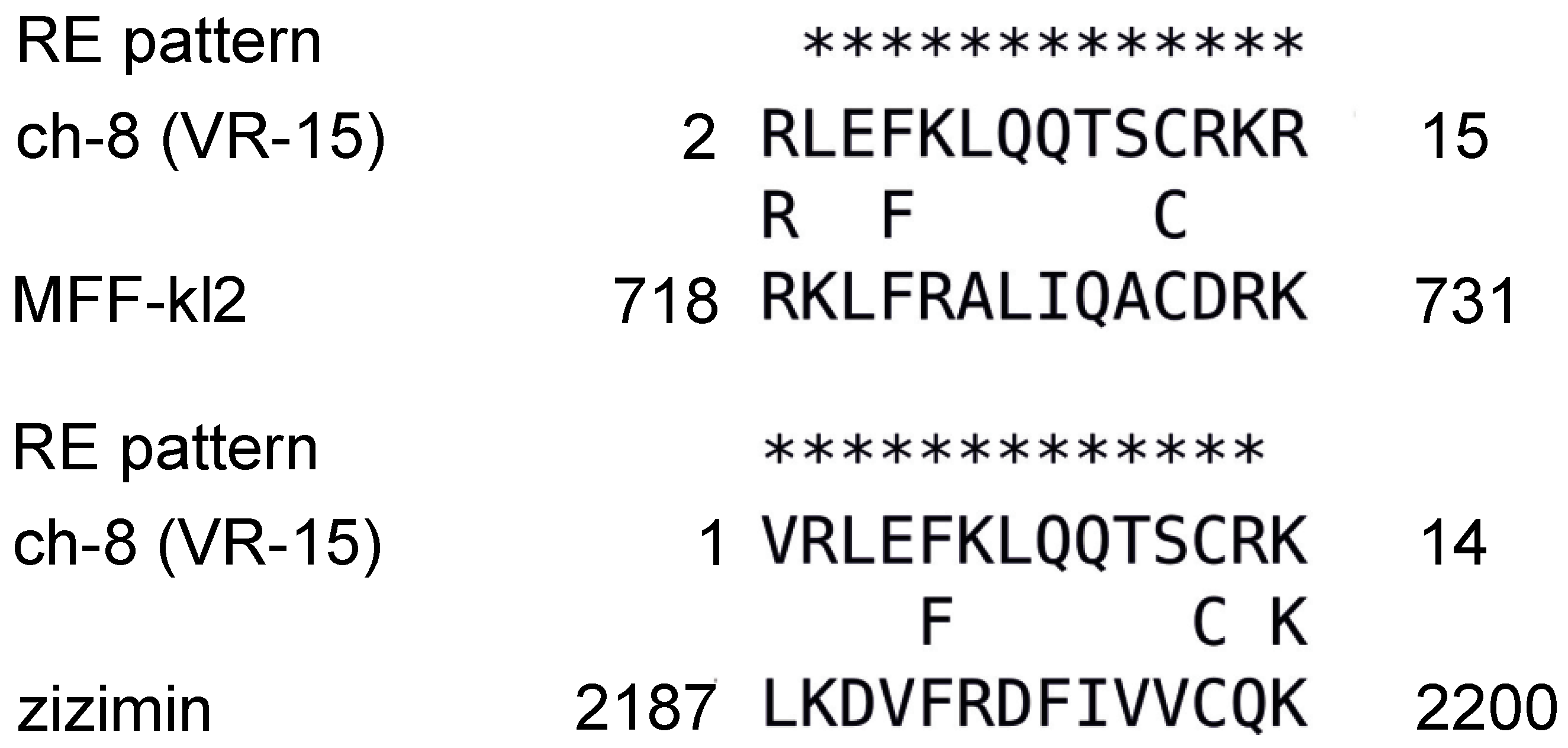
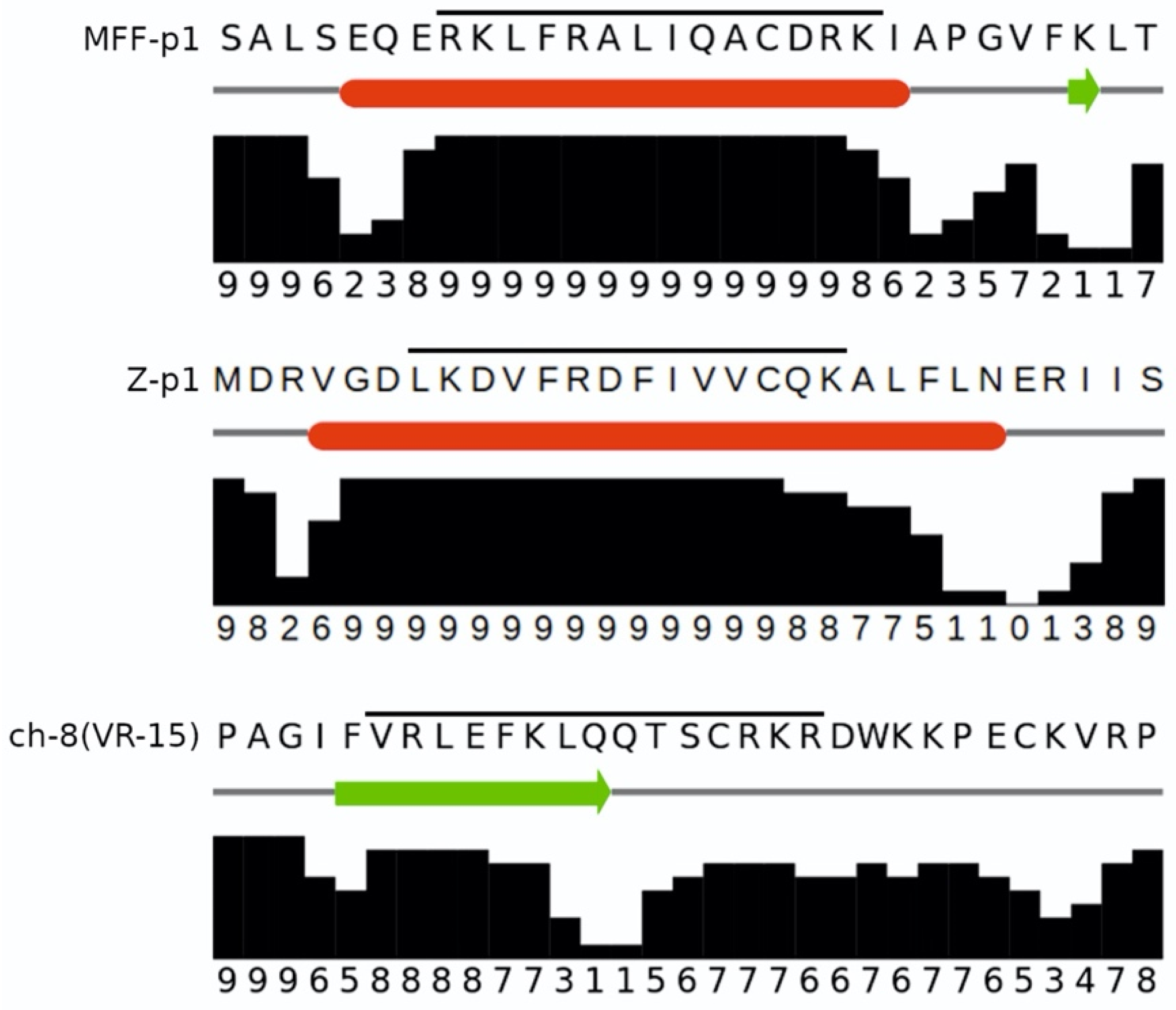
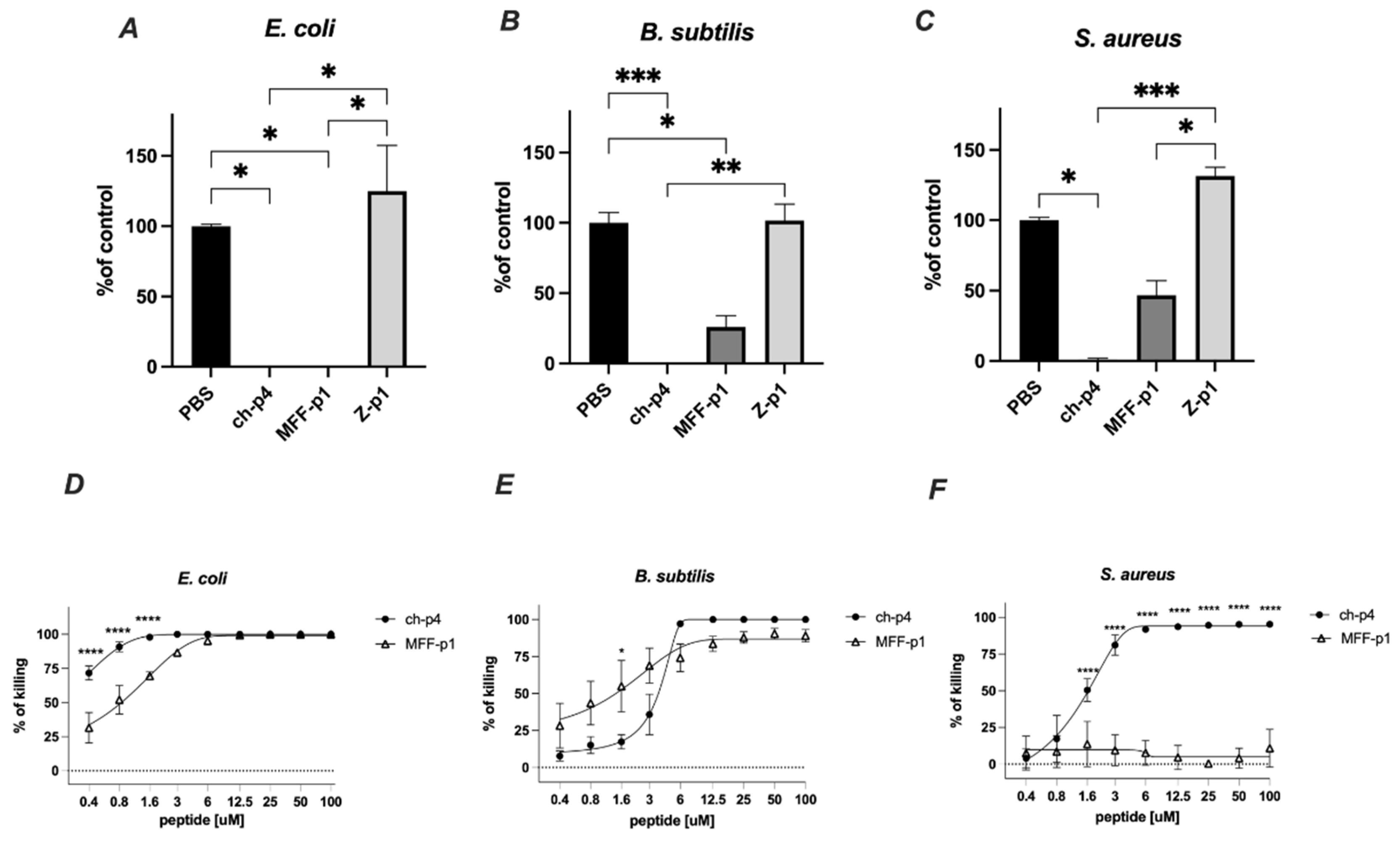
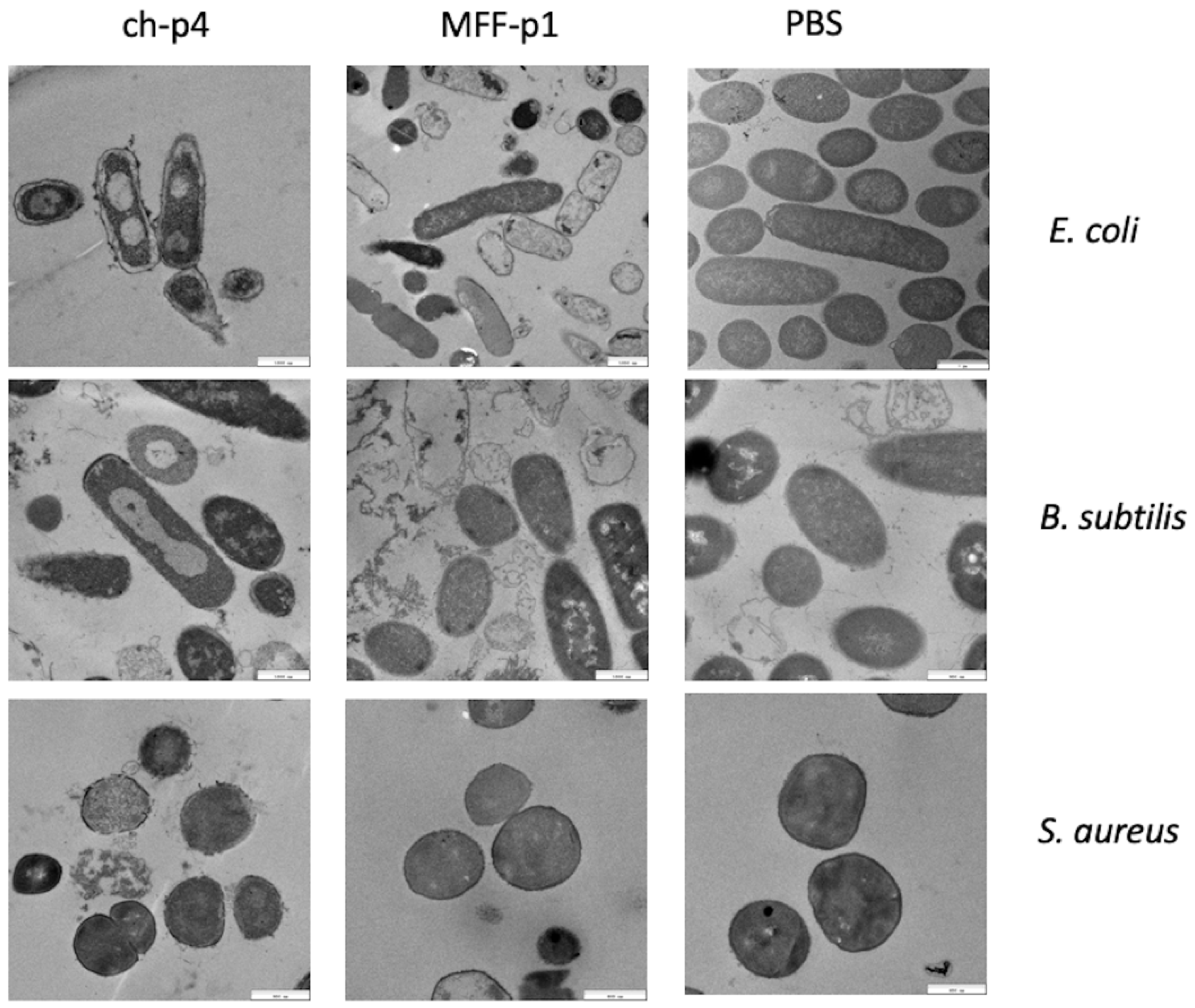
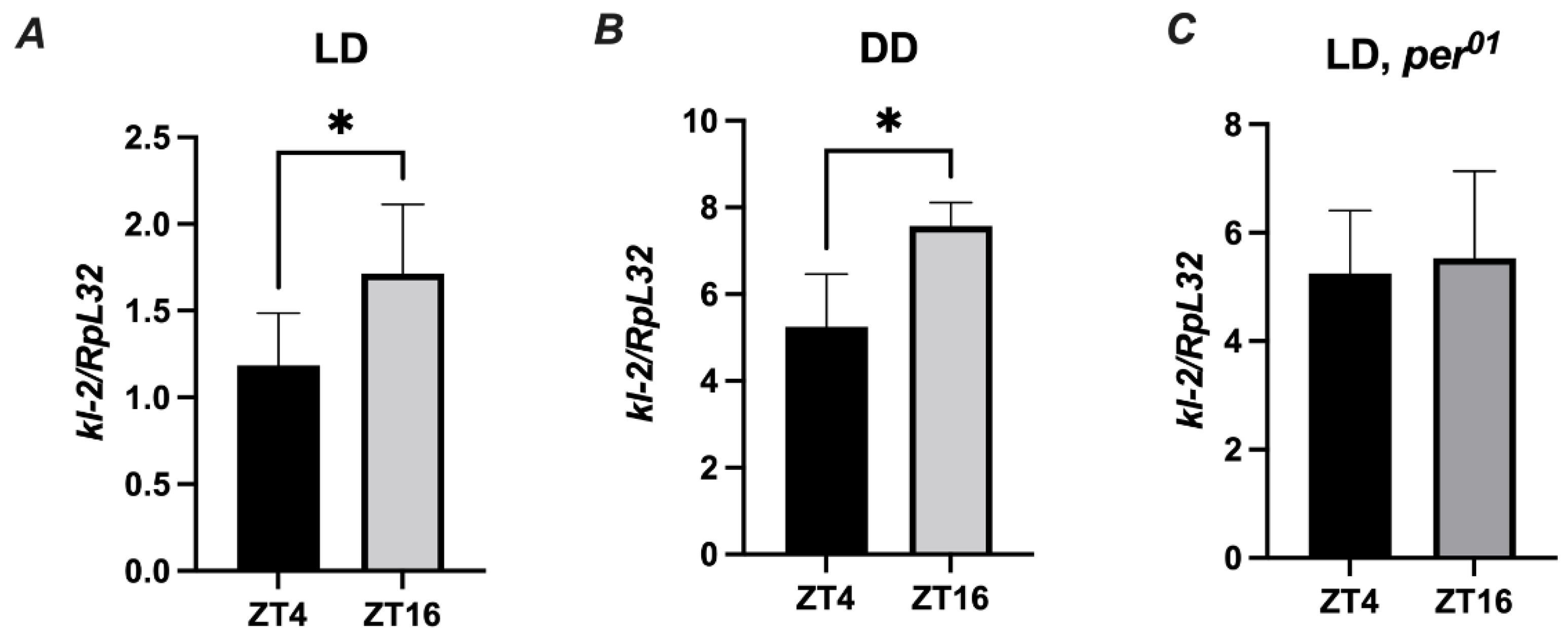
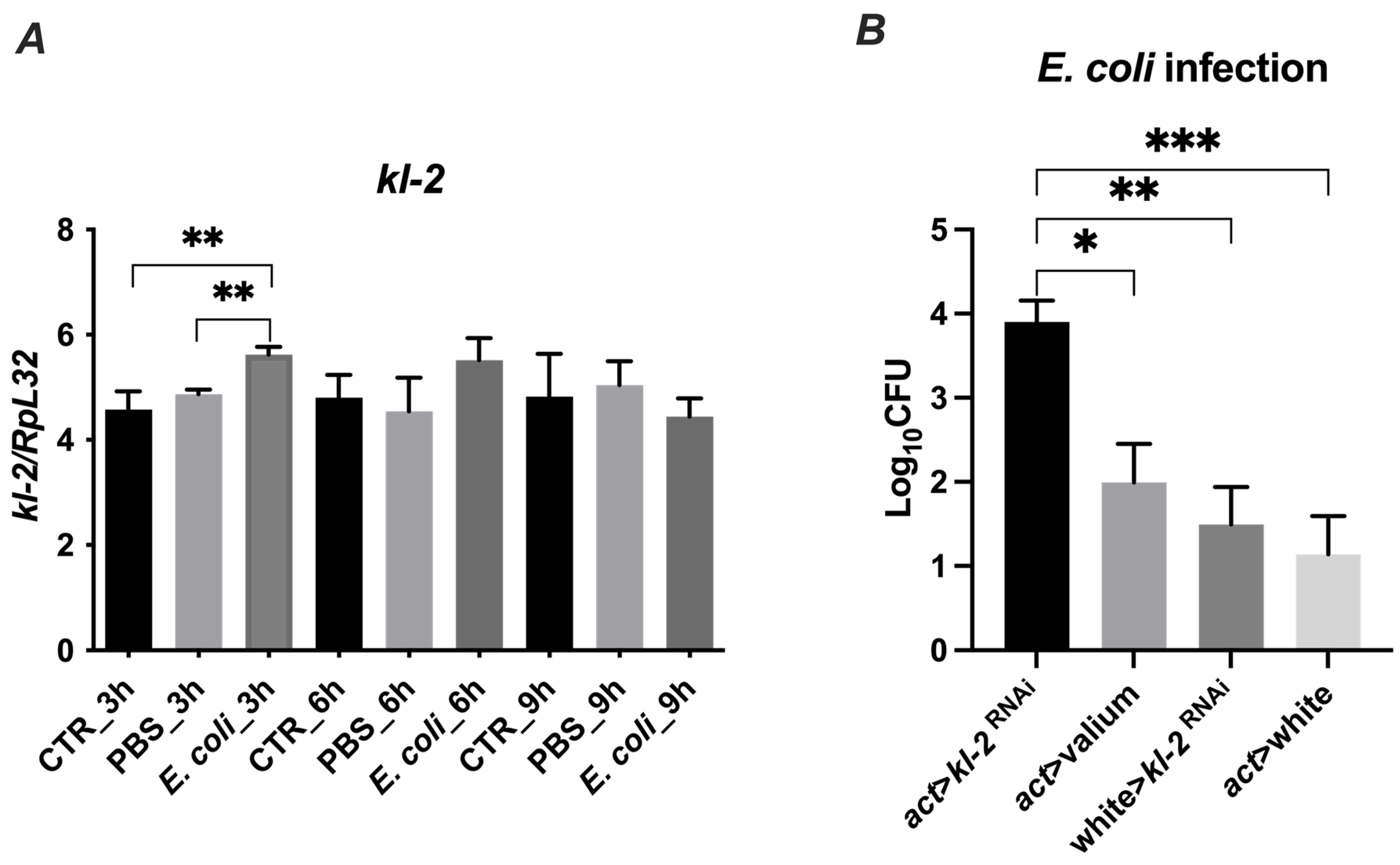
| Peptide Name | Peptide Sequence RE Pattern | #aa | Net Charge | rHMβ | rHMα |
|---|---|---|---|---|---|
| ch-p4 | VRLEFKLQQTSCRKRDWKKP | 20 | +5 | 0.375 | 0.157 |
| [LIV]-[KRH]-X(2)-[WYF]-[KRH]-X(5)-C-X-[KRH](2)-X-[WYF]-[KRH]-X(2) | |||||
| ch-8 (VR-15) | VRLEFKLQQTSCRKR | 15 | +4 | 0.625 | 0.108 |
| [LIV]-[KRH]-X(2)-[WYF]-[KRH]-X(5)-C-X-[KRH]-[KRH] | |||||
| MFF-p1 | RKLFRALIQACDRK | 14 | +4 | 0.143 | 0.548 |
| X(2)-[WYF]-[KRH]-X(5)-C-X-[KRH](2) | |||||
| Z-p1 | LKDVFRDFIVVCQK | 14 | +1 | 0.152 | 0.618 |
| [LIV]-[KRH]-X(2)-[WYF]-[KRH]-X(5)-C-X | |||||
Publisher’s Note: MDPI stays neutral with regard to jurisdictional claims in published maps and institutional affiliations. |
© 2022 by the authors. Licensee MDPI, Basel, Switzerland. This article is an open access article distributed under the terms and conditions of the Creative Commons Attribution (CC BY) license (https://creativecommons.org/licenses/by/4.0/).
Share and Cite
Bilska, B.; Godlewska, U.; Damulewicz, M.; Murzyn, K.; Kwitniewski, M.; Cichy, J.; Pyza, E. Antimicrobial Properties of a Peptide Derived from the Male Fertility Factor kl2 Protein of Drosophila melanogaster. Curr. Issues Mol. Biol. 2022, 44, 1169-1181. https://doi.org/10.3390/cimb44030076
Bilska B, Godlewska U, Damulewicz M, Murzyn K, Kwitniewski M, Cichy J, Pyza E. Antimicrobial Properties of a Peptide Derived from the Male Fertility Factor kl2 Protein of Drosophila melanogaster. Current Issues in Molecular Biology. 2022; 44(3):1169-1181. https://doi.org/10.3390/cimb44030076
Chicago/Turabian StyleBilska, Bernadetta, Urszula Godlewska, Milena Damulewicz, Krzysztof Murzyn, Mateusz Kwitniewski, Joanna Cichy, and Elżbieta Pyza. 2022. "Antimicrobial Properties of a Peptide Derived from the Male Fertility Factor kl2 Protein of Drosophila melanogaster" Current Issues in Molecular Biology 44, no. 3: 1169-1181. https://doi.org/10.3390/cimb44030076
APA StyleBilska, B., Godlewska, U., Damulewicz, M., Murzyn, K., Kwitniewski, M., Cichy, J., & Pyza, E. (2022). Antimicrobial Properties of a Peptide Derived from the Male Fertility Factor kl2 Protein of Drosophila melanogaster. Current Issues in Molecular Biology, 44(3), 1169-1181. https://doi.org/10.3390/cimb44030076






